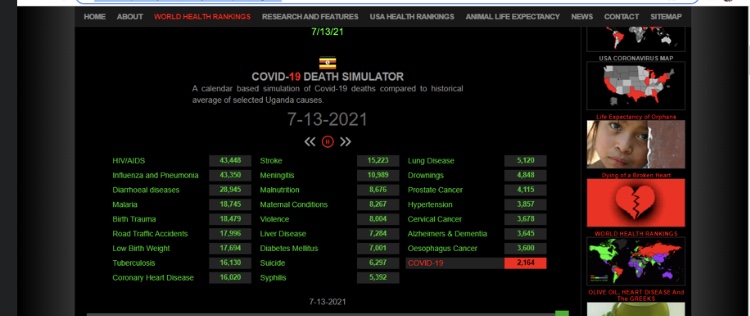KAMPALA: Around 220,500, Ugandans have died from other diseases and non-health causes than COVID-19 over a year and half ago when the pandemic hit the country.
The figure includes other non-health causes such as motor accidents, drownings and suicide.
The first case of the virus was registered in March 2020 and the country has since lost 2,324 citizens to the disease, according to the figures released by the Ministry of Health as at July 14, 2021.
According to a data visualization and simulation website, www.worldlifeexectancy.com, which simulates data from World Health Organisation (WHO), Centre for Disease Control (CDC), United Nations Educational, Scientific and Cultural Organisation (UNESCO), Central Intelligence Agency (CIA) and individual country databases to study life expectancy trends all over the world and in real time, COVID-19 is the least killer disease so far amongst 26 other ranked ailments that have killed Ugandans over the past one and half years.
The simulation we have captured only covers the period between March 1st 2020 and July 14, 2021. This website searched this data up to 19:00 hours on July 14, 2020 in order to file this story but the simulation is a live process using Artificial Intelligence to mine data from the above mentioned organizations. The data shows a cumulative figure and in the case of COVID-19, the number of deaths were obviously at zero on March 1st, 2020 but have accumulated to 2,203 over a period of one and half years. In comparison to other killer diseases, HIV/AIDS which has claimed 38,716 Ugandans claiming the Number 1 position.
The 26 ailments and other causes of deaths in their order of ranking over the past one and a half years, and basing a COVID-19 death simulator as at July 14, 2021, are as follows:
HIV/AIDS (43,448), Influenza and Pneumonia (43,350), Diarrhoeal diseases (28,945), Malaria (18,745), Birth Trauma (18,479), Road Traffic Accidents (17,996), Low Birth Weight (17,694), Tuberculosis (16,130), Coronary Heart Disease (16,020), Stroke (15,223), Meningitis (10,989), Malnutrition (8,676), Maternal Conditions (8,267), Violence (8,004), Liver Disease (7,284), Diabetes Mellitus (7,001), Suicide (6,297), Syphilis (5,392), Lung Disease (5,120), Drownings (4,848), Prostate Cancer (4,115), Hypertension (3,857), Cervical Cancer (3,678) Alzheimers & Dementia (3,645), Oesophagus Cancer (3,600) and COVID-19 (2,164).
“We use the most recent data from these primary sources: WHO, World Bank, UNESCO, CIA and individual country databases for global health and causes of death,” declares a message on the website.
The website however, does not guarantee complete accuracy although its data is captured from reputable disease monitoring global institutions. It assures consumers that for over 10 years the investors and employees of Global Life Partners have provided this public service.
“We measure our success by how many people use the Site to learn more about health where they live and throughout the world. To date we have received well over 100,000,000 page views from virtually every country in the world,” says Tom LeDuc, the founder of Global Life Partners, which is the force behind the website.

Their findings are corroborated by Ministry of Health database which shows 5,027 Malaria deaths were reported in 2019 alone but with 13,576 to have been the estimated deaths according to World Health Organization.
Going by this narrative, it would appear that other than COVID-19 that has received so much attention, the topmost enemies of Ugandans are, in their sequential ranking: HIV/AIDS (43,448), Influenza and Pneumonia (43,350), Diarrheal diseases (28,945), Malaria (18,745), Birth Trauma (18,479), Road Traffic Accidents (17,996), Low Birth Weight (17,694), Tuberculosis (16,130), Coronary Heart Disease (16,020), Stroke (15,223), Meningitis (10,989), Malnutrition (8,676), Maternal Conditions (8,267), Violence (8,004), Liver Disease (7,284), Diabetes Mellitus (7,001), Suicide (6,297), Syphilis (5,392) and Lung Disease (5,120) which calls for equal attention in scale and velocity by the Government.
In the case of HIV average annual deaths data, this discovery fits well with the annual deaths data rage for the year 2020 of 22,000-27,000 according to empirical evidence on the UNAIDS web platform.

“This information is good for qualitative inferences, judgements and comparison purposes in order to help the nation understand the gravity of our health complications that go unmentioned due to the surge in the COVID pandemic attention,” says a health expert on condition of anonymity.

















